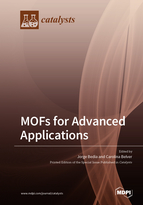MOFs for Advanced Applications
A special issue of Catalysts (ISSN 2073-4344). This special issue belongs to the section "Catalytic Materials".
Deadline for manuscript submissions: closed (31 December 2020) | Viewed by 86033
Special Issue Editors
Interests: chemical engineering; metal–organic frameworks (MOFs); carbon materials; water treatment; adsorption; advanced oxidation processes (AOPs); photocatalysis
Special Issues, Collections and Topics in MDPI journals
Interests: chemical engineering; materials science; adsorption; photocatalysis; semiconductors; MOFs
Special Issues, Collections and Topics in MDPI journals
Special Issue Information
Dear Colleagues,
Metal organic frameworks (MOFs) are a class of porous materials with a modular structure. This allows for a very wide structural diversity and the possibility of synthesizing materials with tailored properties for advanced applications. Thus, MOF materials are the subject of intense research, with strong relevance to both science and technology. MOFs are formed by the assembly of two components: Cluster or metal ion nodes, which are also called secondary building units (SBUs), and organic linkers between the SBUs, usually giving rise to crystalline structures with an open framework and significant porous texture development. The main aim of this Special Issue of Catalysts (ISSN 2073-4344) is to present the most relevant and recent insights in the field of synthesis and characterization of MOFs and MOF-based materials for advanced applications, including adsorption, gas storage/capture, drug delivery, catalysis, photocatalysis, and/or chemical sensing. Some of the key topics relevant to this Special Issue are:
- Synthesis and characterization of novel MOFs or MOF-based materials, including new synthetic routes;
- Porous MOFs for adsorption and gas storage/capture;
- Drug delivery application with MOF based-materials;
- Catalysis and photocatalysis with MOFs;
- Synthesis of MOFs for chemical sensing;
- Energy storage in MOFs.
We look forward to your submission.
Prof. Jorge Bedia
Prof. Carolina Belver
Guest Editors
Manuscript Submission Information
Manuscripts should be submitted online at www.mdpi.com by registering and logging in to this website. Once you are registered, click here to go to the submission form. Manuscripts can be submitted until the deadline. All submissions that pass pre-check are peer-reviewed. Accepted papers will be published continuously in the journal (as soon as accepted) and will be listed together on the special issue website. Research articles, review articles as well as short communications are invited. For planned papers, a title and short abstract (about 100 words) can be sent to the Editorial Office for announcement on this website.
Submitted manuscripts should not have been published previously, nor be under consideration for publication elsewhere (except conference proceedings papers). All manuscripts are thoroughly refereed through a single-blind peer-review process. A guide for authors and other relevant information for submission of manuscripts is available on the Instructions for Authors page. Catalysts is an international peer-reviewed open access monthly journal published by MDPI.
Please visit the Instructions for Authors page before submitting a manuscript. The Article Processing Charge (APC) for publication in this open access journal is 2700 CHF (Swiss Francs). Submitted papers should be well formatted and use good English. Authors may use MDPI's English editing service prior to publication or during author revisions.
Keywords
- MOFs
- gas storage
- adsorption
- catalysis
- photocatalysis
- CO2 capture
- energy storage
- drug delivery







